No products in the cart.
German motorcycles, Maico
The German Side: A History of Maico Fahrzeugfabrik
(From the Beginning to the 1970s)
The cubist, brightly-colored motorcycles that fascinated American racers originated in a small automobile repair shop in post-World War I Germany. Maico (“Maisch & Company”) was formed in Poltringen, an industrial town in the southwest corner of Germany. The year was 1926—the same year the reparations-wracked and starving country was admitted to the League of Nations. Company founder Ulrich Maisch began the business in a garage, providing 24-hour automobile service, and also sold bicycle and motorcycle parts. Ulrich had two sons—Wilhelm and Otto—who entered the business following their schooling. By 1931 the boys decided to expand the family business by assembling complete bicycles for sale. In the still-devastated German economy of the time, this was a sensible, clear-headed enterprise: producing cheap locomotion. By 1935 the brothers ventured even further, producing their own, complete motorcycle. The first machine was little more than a bicycle frame powered by a small engine; an Ilo at first, and later a small Sachs unit.
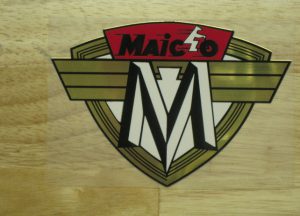
Maico’s Beginnings and WW2
On February 27th, 1933, four years after the crash of the American stock market and in the midst of the Great Depression, the firebrand leader of the recently ascendant German National Socialist (Nazi) Party Adolf Hitler had blamed Marinus van der Lubbe, George Dmitrov, and other foreign communists for a fire in the Reichstag building. The crisis lent Hitler the opportunity to send some 11,000 German communists and other non-conformists off to concentration camps—from which few returned. Decrees after the fire gave Hitler carte-blanche to consolidate his power. By March 1933 Hitler was in effect the dictator of the former democracy, in the position to implement his plans for domination of Germany and the rest of Europe. His ambitions included subjugating neighboring Czechoslovakia, a task facilitated by British and French diffidence at the 1938 Munich Conference.
In 1939, early in the morning on the 15th of March, German troops moved across the misty border into Czechoslovakia, northeast of Pfeffingen. After a fierce but doomed fight by the Czech armed forces, the Germans placed the country under the Nazi flag. With its capitulation the nation’s independence was ended for six decades, and it was opened to exploitation by the Third Reich.
Some of that exploitation would be economic. Czechoslovakia offered a healthy and advanced industrial base, with a trained labor force. German businesses took advantage of the new situation. Later in 1939, the Maisch families moved their growing enterprise into a new facility, close to the Czech border, near Pfeffingen, with Ulrich’s sons Otto and Wilhelm now running the company. In that same year the brothers displayed their Maico motorcycles at an exhibition in Berlin. The future for the family, colored by Germany’s rejuvenation, remained bright.
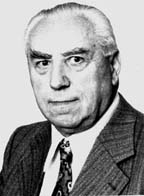
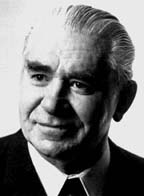
Observing the events in Czechoslovakia, Hitler’s proclamations, and the overall German mood, the Maisch brothers likely discussed the chances of a coming government-mandated change in their product line; from motorcycles to war materiel. As Germany again dragged Europe into war, the Maisches found themselves in the aircraft parts business. For the next six years, as part of mobilized German industry, Maico joined BMW, Porsche, Mercedes and other manufacturers in keeping the Luftwaffe flying and the Wermacht fighting. Because Maico was by this time manufacturing and assembling high quality motorcycle components, using advanced machine tools and employing skilled workers, the changeover to airplane parts was a relatively easy one.
By 1944 Hitler’s Germany had transformed to a smoking, besieged fortress, mercilessly pounded from above each day and night by American and British bombers. By fall, the remainder of the country was under imminent invasion threat by the Russians in the east and the American, British and Canadians in the west. On April 30th, Hitler killed himself in his bunker, with the Red Army only blocks away. A few days later the tattered remnant of German military government surrendered.
Rising From the Ashes of a Broken Country
In 1945 the Maisch family would have looked out from their relatively unscathed Pfeffingen, across the pulverized and ruined industrialized areas of Germany. They witnessed an economic reality not far removed from the company’s beginnings in the 1920s. Their broken country was once again in need of basic transportation. Turning from armaments back to motorcycles, the brothers continued development of more advanced machines on which they had stopped work five years earlier. The first Maico with a Maico-built engine (the model M150) rolled out in 1949. Good fortune fell upon the brothers as they and their West German neighbors enjoyed relative freedom in the Allied sector, safe from the economic and political oppression of the Russian zone. Otto now ran Maico, as a result of Wilhelm’s wartime National Socialist party membership, which ran afoul of de-Nazification policies in the West.[1] These rules precluded former Nazis from owning controlling shares of German firms. Otto now possessed 60% ownership, while Wilhelm, the ex-National Socialist, retained 40%.
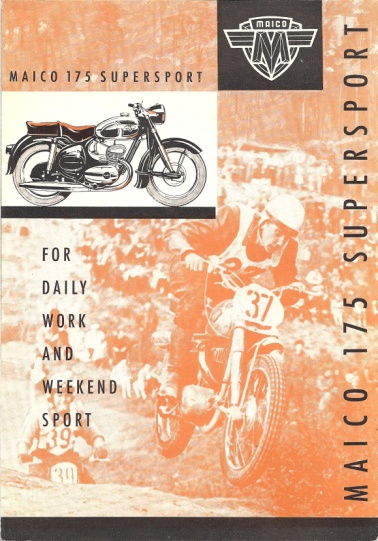
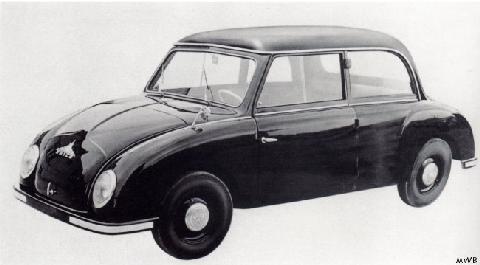
Providing motorcycles to a rebuilding nation was profitable. During the 1950s Maico thrived. The company developed new and well-engineered motorcycles, scooters, and a small car with a Heinkel engine for the recovering German middle-class, who by now were ready for the comforts of automobile ownership.[2] The road-going Taifun motorcycle, in particular, emerged as a marvelously engineered and executed two-stroke twin-cylinder machine, in either 350cc or 400cc versions. GS (“Gelandesport”—meaning “on/off-road”) versions of the growing line of M150, M175, and M250 machines were offered, and Maico began to develop a reputation for good off-road and competition motorcycles—a product unique at the time. Quality became the company’s hallmark. Road-racer and engineer Eric Bley recalled from his childhood in Germany that Maico’s machines were just “a little bit better” than what their competitors BMW, Kreidler, NSU, and others were offering.[3] To summarize the company’s strength in terms motorcyclists understood, Maico effectively incorporated simple two-stroke, unit-design engines into rugged, good-handling frames with reasonable suspension.[4]
Maico continued to develop new machines and expand within the small-to-midsized motorcycle market. The Maicoletta scooter was a large machine in comparison to contemporary and even later scooters, but was fast and ingeniously designed, incorporating relatively large engines twin-cylinder engines in an aerodynamically enclosed body. Incorporating new technologies on all their products, chief engineer Ulrich Pohl and other designers departed from engineering norms of the day in pursuit of the best performing machine possible—a characteristic of Maico that caused them to stand out among other manufactures. This quest for top quality drew the attention of motorcycle enthusiasts in Germany and, increasingly, in Europe and abroad.
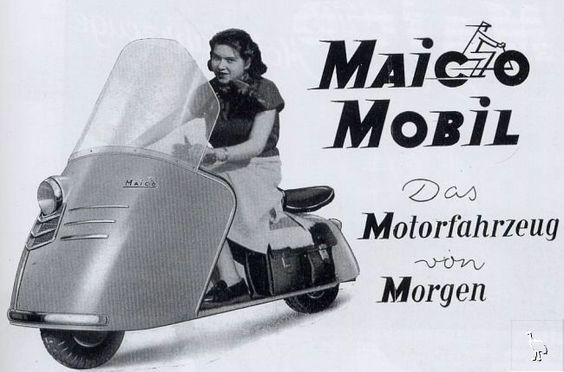
The Blizzard road motorcycle rounded out Maico development in the 1950s, with the production of two more street bikes, the two-stroke rotary-valve MD-50 and MD-125, beginning in the 1960s.[5] Commercial pitfalls occurred along the way. A bankruptcy in 1958 (the first of two; the latter being the fatal event in 1983) was fueled in part by Germans’ growing disenchantment with small motorcycles as basic transport, in part by a bad overall economy, and in part by the commercial failure of the Maico automobile project. This led to an unforeseen and timely opportunity for Maico, when the West German government ordered 10,000 motorcycles from the company for the German army.
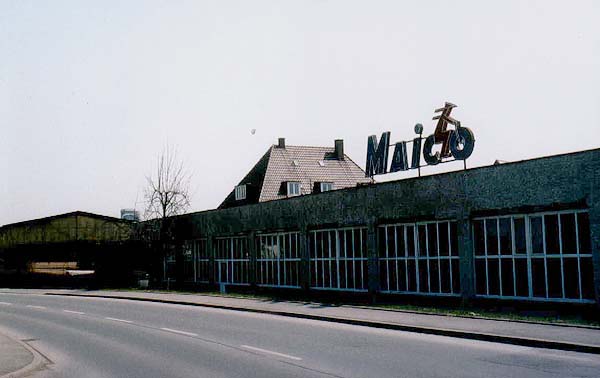
From this even greater emphasis on dual-purpose (on- and off-road) motorcycles for the Army in the very late 1950s, off-road and competition bikes became Maico’s bread-and-butter line. They would remain so for the rest of the corporation’s history. This emphasis on dual-purpose bikes was rare for a European motorcycle producer. The only similar situation at the time was that of Sweden’s Husqvarna factory. Maico’s iron “oval-barrel” engines gave way to the late-1960s “square-barrel” alloy motors under engineers Gunther Schier and Kottlep Hafs. Maico actively supported racing and sponsored Maico riders, and German stars such as Herbert Schek and Lenz Muller (enduro), Toni Gruber (road-racing), and Adolf Weil (scrambles/motocross) became associated with the brand then. Exports to North America, begun in the 1950s, increased greatly. Dennie Moore, of Reedsville, Pennsylvania, and Frank Cooper, of Burbank, California, emerged as the major American distributors and marketers of Maico motorcycles. Moore and Cooper were motorcycle enthusiasts themselves, who keenly understood both their audience and their product. Their promotion of the German bike succeeded due to personal motivation and to the intrinsic quality of the Maico.
The Late 1960’s and 70’s – American Motorcycle Culture’s Pivotal Age
The late 1960s and early 1970s were a pivotal age for American motorcycle culture. The post-war market of performance-conscious American riders wanted the best motorcycles available, now having options not only beyond Indian and Harley-Davidson, but outside the 1950s influx of British Triumphs, Nortons, and BSAs as well. Continually refined in European racing, Maico off-road motorcycles improved every year. By the late 1960s, the classic “coffin-tank, square-barrel” Maico design was well known in North America as a top-quality competition machine, and became a staple of the American scrambles and motocross circuits. In 1973-1974, at the height of American motorcycle sales, they were—despite a list of minor faults—better handling, simpler, quicker, and offering more possibilities for further enhancement any other off-road motorcycle then available.[6] Maico was understood to be a motorcycle designed from the ground up for off-road use; one of the very first of such creations in the world. It was not a street or general-purpose machine which needed adaptation for off-road riding and racing, but a singularly designed off-road competitor. Additionally, its functionality caused it to visually resemble nothing else on the market. To own a Maico was to own a visually unique machine, expressly made for what more and more American riders like to do: race their motorcycles in rugged off-road conditions. For many of these riders, Maico was synonymous with the best machine a rider could own; a device not only revered in its own right, but carrying with it the panache of the German reputation for quality engineering.
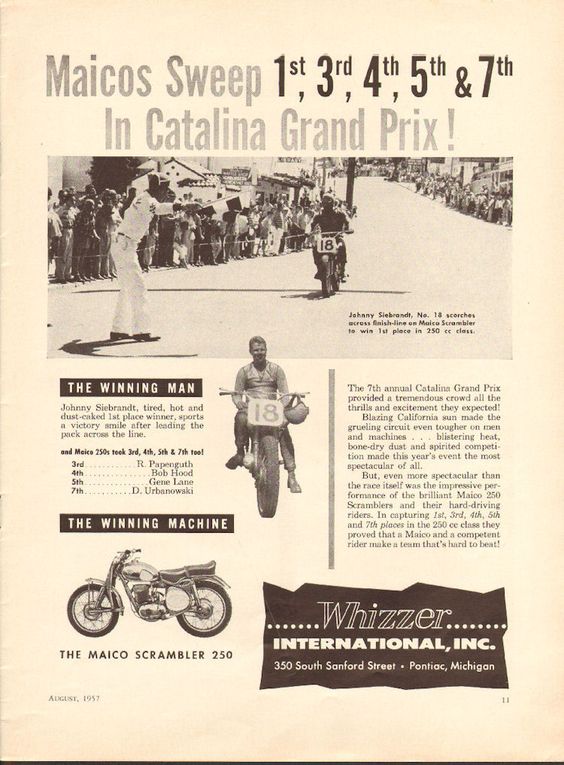
Aware and comfortable with their niche by the 1960s, Maico refined its focus throughout that decade on off-road competition motorcycles. Increasingly, the firm received press and public attention for its high-quality products. In the United States, the European motocross-refined Maico fit perfectly into the burgeoning American translation of the sport, of course, but also found considerable niches in both flat-track racing (to include all the variations: quarter-mile, half-mile, and mile) and enduro.[7] Dealers in small and large towns throughout America sold every Maico they could obtain from the distributors, usually before they even took receipt of the motorcycle.[8] As the 1960s decade ended, Maico was arguably producing the finest off-road motorcycle obtainable.
In the United States during this time, dissention over the war in Viet Nam remained an open national wound, as Richard Nixon was inaugurated President on January 20th, 1969. Nixon promised change. The 1960s had already transformed the United States and the world with a new freedom of experimentation and “personal liberation,”[9] and one characteristic of the period was the interest in the personal mobility afforded by the motorcycle. If historian David Potter was correct, and Americans can be defined by their tendency to move and compete—the skyrocketing growth of motorcycle riding and competition during this time was a predictable conclusion.[10] In any event, as the prosperity that initially fueled post-war motorcycle interest continued, it was amplified by a new cultural paradigm of venturing beyond the safe and predictable. The United States had just landed a man on the moon; Americans were crossing boundaries and finding their own paths—all trends which found ready expression in off-road motorcycling. The sport was positioned to exemplify larger cultural trends, especially for that large segment of Americans who liked machinery and speed.
As the 1970s began, Maico best talent spent the majority of its energy on off-road machines. Engineers Reinhold Weiher and Ladislav Gorgos, joined soon by the young and energetic Indian expatriate Selvaraj Narayana, continued the steady improvement of the off-road machines.[11] Otto Maisch assumed complete corporate leadership, since brother Wilhelm had been sidelined since the late 1950s, run over by a motorcycle while watching a race. The company thrived. Joining prior race-team members Schek, Muller, and Weil were new stars Dieter Braun and Borje Jansson (road-racing), Egbert Haas (enduro), and Ake Jonsson and Willi Bauer (motocross). Jonsson, in particular, would bring the company as close as it would ever be to winning a world championship; his brilliance and Maico’s well-earned prominence only foiled by chance misfortune.[12] To competitors and fans, these men were undeniably sports superstars, and their association with Maico lent luster to the brand.
Motorcycle Culture Hits Hollywood
Popular culture expressions in the United States at the time—mostly movies and television—tended to focus on the growing anti-social connotation of motorcycling, such as that led by Marlon Brando’s character in 1954’s The Wild One, yet motorcycle competition and interest in riding by everyone—to include Hollywood stars—grew at the same time. Actor Steve McQueen was the most famous example of Hollywood’s infatuation with motorcycle culture. McQueen, who rode and competed on many brands and also represented America at the 1964 International Six-Day Trials competition in East Germany, understood, as did his fans, the appeal of pushing a machine to the brink of its performance capabilities under demanding and unpredictable conditions.
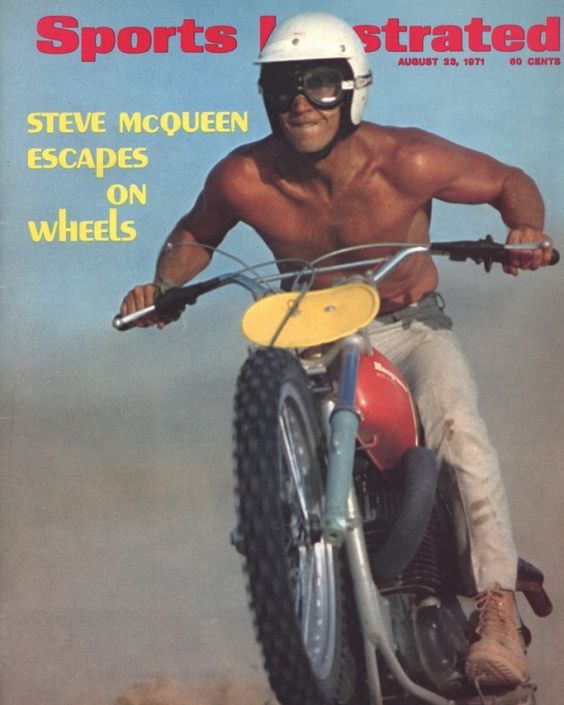
This appeal was the essence of the growing sport of motocross. McQueen, though forever associated with the Swedish Husqvarna brand, a competitor with Maico, remains an icon to all dirt bike riders, world-wide.
Obviously, the United States represented a prime market for any motorcycle producer. Throughout the decolonizing, developing world, including Asia and Africa, small motor-bikes functioned as basic transportation.[13] Poor roads, the lack of public transportation systems, expensive or hard-to-find gasoline, and limited purchasing power all made the motorcycle a natural response in Third World and underdeveloped nations. In the United States and the developed countries, motorcycles were purchased for different, self-actualizing reasons: sporting use, image, and the pursuit of performance—as well as transportation. Road-riding Americans avidly consumed fast, technically advanced, large-capacity, powerful machines.[14] American preferences for high-performance led buyers to the high-end off-road sporting motorcycles such as those made by Maico.
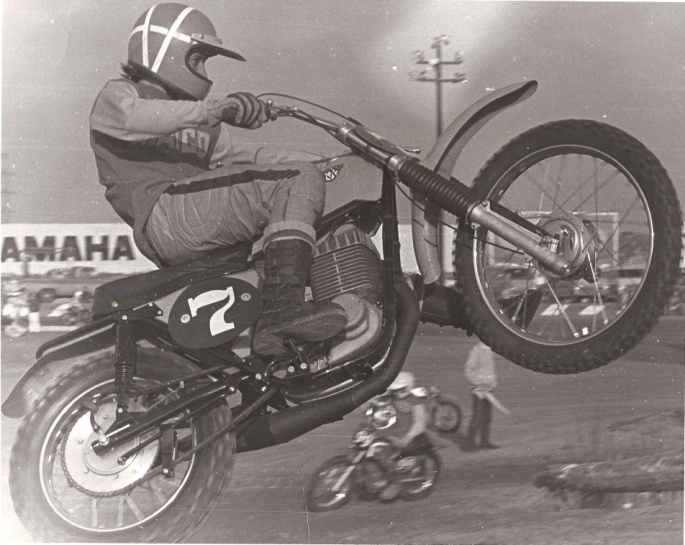
To quickly create the dealer network necessary to move motorcycles, German Maico allowed American Maico distributors to make the process of becoming a dealer extremely easy. This casual acceptance of new dealers—many just individuals working out of their garages—represented one of the company’s major successful policies in penetrating the United States market. The creation of a dealer network, from which the products imported by the distributors could be sold and serviced, was essential to increased sales. All motorcycle companies, including the largest Japanese corporations, allowed and encouraged a quick dealer network establishment. Shop owner Gig Hamilton recalls the minimum requirement for being a Yamaha dealer at the time as “buying two bikes, $50 to $100 worth of parts . . . and a sign!” His requirement to be a Maico dealer (Hamilton was the first dealer signed under Eastern Maico distributor Dennie Moore in 1968) was even less taxing: buying one motorcycle sufficed.[15] Like Dennie Moore and Maico itself, other proponents of the high-end, imported ‘boutique’ off-road machines took to the road to create the necessary dealer network. On the American west coast, Husqvarna importer Edison Dye had been at work for several years, hiring Swedish motocross stars Lars Larsson and Torsten Hallman in 1965 and 1966 to come to the United States and travel the developing motocross circuit from town to town. The Swedes raced with and invariably amazed the American riders with their skill and the bike’s abilities, signing-up plenty of new Husqvarna dealers and generating great interest in motocross in their wake.[16] Dye knew motocross would engage America, and in the process of promoting it, he created a market for the Swedish Husqvarna motocross line he was importing as well as whetting American’s appetites for other high-quality European dirt bikes.
Motorcycle distributors were then racing against one another to establish dealer networks. By the early 1970s, virtually any American hardware store, welding shop, or auto garage might have had several European dirt bikes in the display window. More than likely, the owner or his son also rode, and the small franchise did double-duty as both profit generator and a source of racing motorcycles and parts at a discount. Maico, CZ, Rickman, and Puch were some of the makes commonly offered for sale in the storefronts of small American businesses, side by side with the lawnmowers and automotive parts. This arrangement of foreign-built products in these small businesses was unique for the time, and is one example of off-road motorcycling transcending boundaries. Though British motorcycles had long been imported to America, the major British North American distributors—like the American manufacturers—placed basic minimum floor space and inventory requirements on retailers that effectively prohibited the minimalist business model these new European brand micro-dealers enjoyed. A similar arrangement can currently be seen now, at American auto-part stores which sell Chinese-made motorbikes and four-wheelers, which are now seeking to impregnate the established Japanese-made market.
As noted, by this time in the early 1970s, Maico produced—arguably, and if only by degrees—the finest off-road motorcycles in the world.[17] Challengers such as Husqvarana and CZ—and soon Honda, Yamaha, and Kawasaki—did make inroads with enthusiasts, but Maico’s association with top performance remained entrenched. The company again upgraded their winning off-road motorcycle line in 1972 with the introduction of the improved “radial”-head engine, first in 250cc and then in 400 and 440cc. Maico also continued to improve the newer 125cc and 501cc MC/GS models, although these models did not sell as well—at least in the United States—as the 250cc-450cc models.[18] The single-cylinder RS125 road-racer remained a highly competitive machine, even when compared to the multi-cylinder offerings of the Japanese “Big Four,” and collected many European National Champion and Grand Prix wins.
Maico’s North American sales counted for approximately fifty percent of the company’s total world-wide sales during this period, and the moderately-sized German company clearly dominated the high-end off-road competition motorcycle market in America. Maicos were particularly favored by open-class (the “unlimited” engine capacity class) competitors. Period racers have stated anecdotally that Maico motorcycles often composed half or more of all motorcycles entered in an average open-class motocross race in America, in the early 1970s.[19]
[1] Membership in the National Socialist Party. Wilhelm’s precise reasons for joining the party are unknown. Whatever the Maischs may have felt about Adolf Hitler and his policies, it is a fact that observing Hitler’s ascent to unquestioned power, vast numbers of Germans “saw the light” and joined the party as a matter of practicality (early Nazi party members—the “old fighters” who supported Hitler when doing so incurred much greater risk— referred to these later converts as “spring violets”, noting derisively that these soft new recruits came to the party long after the hard fight of the previous two decades was behind them, where such great numbers might have actually been useful). From a pure business perspective, it is reasonable to assume that the Maischs were hedging their bets for the future; with one half-owner in the party, and one half-owner outside. If this was the case, it succeeded—though probably unforeseen by Otto and Wilhelm—in keeping ownership in the family.
[2] Interview with Eric Bley by David Russell, March 21, 2008, Harrisburg, Pennsylvania (Russell Motorcycle Sport Collection, Center for Pennsylvania Culture Studies, Penn State Harrisburg).
[3] Interview with Eric Bley by David Russell.
[4] Unit-design implies a reciprocating engine wherein the crankshaft (driving) output and the (driven) gearbox are connected and located within the same housing. Motorcycle engine designs prior to mid-century often incorporated separate engine and transmission units; this design known as “pre-unit.”
[5] Rotary-valve is a system of two-stroke air/fuel induction in which the carburetor feeds directly into the crankcase, past a rotating disc (valve) splined to the crankshaft and controlling inlet timing and duration.
[6] Dirt Bike, “1975 Maico 250: If you ride one, you’ll have to buy one,” Dirt Bike (November, 1974), 65.
[7] Flat-track racing is one of the oldest motorcycle competition events. Run on flat, unpaved tracks—such as those found on local American fairgrounds—flat-track developed from this widely-available resource. Enduro competition involves the traversing of sometimes vast expanses of natural terrain, while maintaining a prescribed pace.
[8] Interview with Dennie Moore by David Russell, March 27, 2007, Harrisburg, Pennsylvania (Russell Motorcycle Sport Collection, Center for Pennsylvania Culture Studies, Penn State Harrisburg).
[9] Terry Anderson, The Sixties, 2d ed. (New York: Pearson Longman, 2004), 143.
[10] David Potter, People of Plenty: Economic Abundance and the American Character (Chicago: University of Chicago Press, 1958), 48-9.
[11] Ladislav Gorgos and Selvaraj Narayana would both later join Austrian motorcycle giant KTM, after Maico’s demise.
[12] The “blown spark-plug incident.” See chapters on Ake Jonsson and Selvaraj Narayana for their versions of this story.
[13] Steven E. Alford and Suzanne Ferris, Motorcycle (London: Reaktion Books, 2007), 62-5.
[14] Large, fast motorcycles. Motorcycle riders in the post-World War II United States tended to purchase larger-capacity machines in greater numbers than citizens of other countries. The reasons for this were three-fold. First, gas prices in the United States tended to be lower than in other countries. Second, the country was large, with—beginning in the 1940s—a good road system. Third, the government of the United States—unlike European countries such as Sweden, Great Britain, and Italy—did not legislatively limit the use of larger-capacity machines. Sources for these ideas include: Interview with Gunnar Lindstrom by David Russell, January 27, 2008, Harrisburg, Pennsylvania (Russell Motorcycle Sport Collection, Center for Pennsylvania Culture Studies, Penn State Harrisburg); Lindsay Brooke and David Gaylin, Triumph in America (Osceola: Motorbooks International, 1993), 37-60; and Steve Koerner, The Strange Death of the British Motorcycle Industry (Lancaster, UK: Carnegie Publishing, 2012), passim.
[15] Interview with Gig Hamilton by David Russell, June 19, 2007 and April 7, 2008, Harrisburg, Pennsylvania (Russell Motorcycle Sport Collection, Center for Pennsylvania Culture Studies, Penn State Harrisburg).
[16] Gunnar Lindstrom. Husqvarna Success (Stillwater, MN: Parker House Publishing: 2010).
[17] Maico being the finest off-road machine available in the 1960s and 1970s is corroborated by many industry observers and professional racers. In this dissertation, these include Gunnar Lindstrom and Eric Bley in chapter 2, Dennie Moore in chapter 4, and Denny Swartz and John Barclay in chapter 5.
[18] Interview with Charles Schank by David Russell, October 6, 2009, Harrisburg, Pennsylvania (Russell Motorcycle Sport Collection, Center for Pennsylvania Culture Studies, Penn State Harrisburg).
[19] Interview with Craig Shambaugh by David Russell.

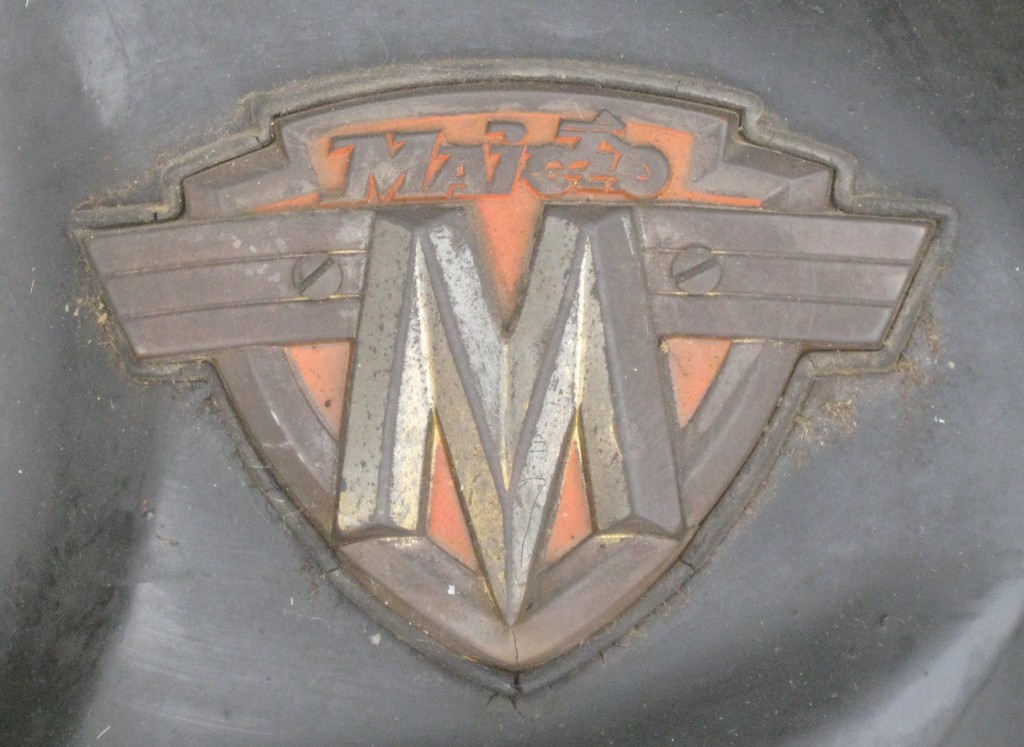
Hello, I have a Maico 400 and love it so much that I started a small shop fixing Maicos… My latest improvement to the shop is buying old worn out gas tanks and patching them up–my metallurgical engineering degree came in handy during the early stages of removing the dents in the old coffin-styled aluminum tanks.
I now am working on color matching the fiberglass tanks and have run into a roadblock… There is no literature regarding Maico’s beautiful red color scheme on their 1969-1972 models. I want to match their red as close as possible. I lucked out with their yellow and have completed 15 orders. But their red still eludes us! Can you put me in touch with some one from their glory days who can help? Thanking you in advance, Michael Dolce
Hi, Michael. Let me reach out to a friend of mine who’s been reproducing Maico fiberglass. He may be able to help out. Dave
Michael, sorry to be so late getting back to you. I’ve run into the same problem–no-one can give me a color code for the classic Maico colors. Maico legend has it that the colors in this late-sixties/early seventies zone were actually identical to certain Volkswagon colors, but I’ve been unable to really confirm this. Everyone I’ve asked about actual codes has told me that they simply had a remaining piece of original paintwork scanned at the painter’s, and used the resulting formula. Sorry! Please let me know how your search winds up! Dave
Hi, looking for info on 1956 maico 175s blizard .i have one cant find any thing about her, repair manules ext. The cluch an frount grips come off end of handle bar cables run through same . any info would be great.
That’s a tough one, Brad! Afraid I don’t have access to any manuals or tech data on them, other than what I received from my sources in the essay. I do know that these bikes were considered very good machines; “just a little bit better” than everything else of the era, as Eric Bley remarked. Anybody else have anything on these? Dave